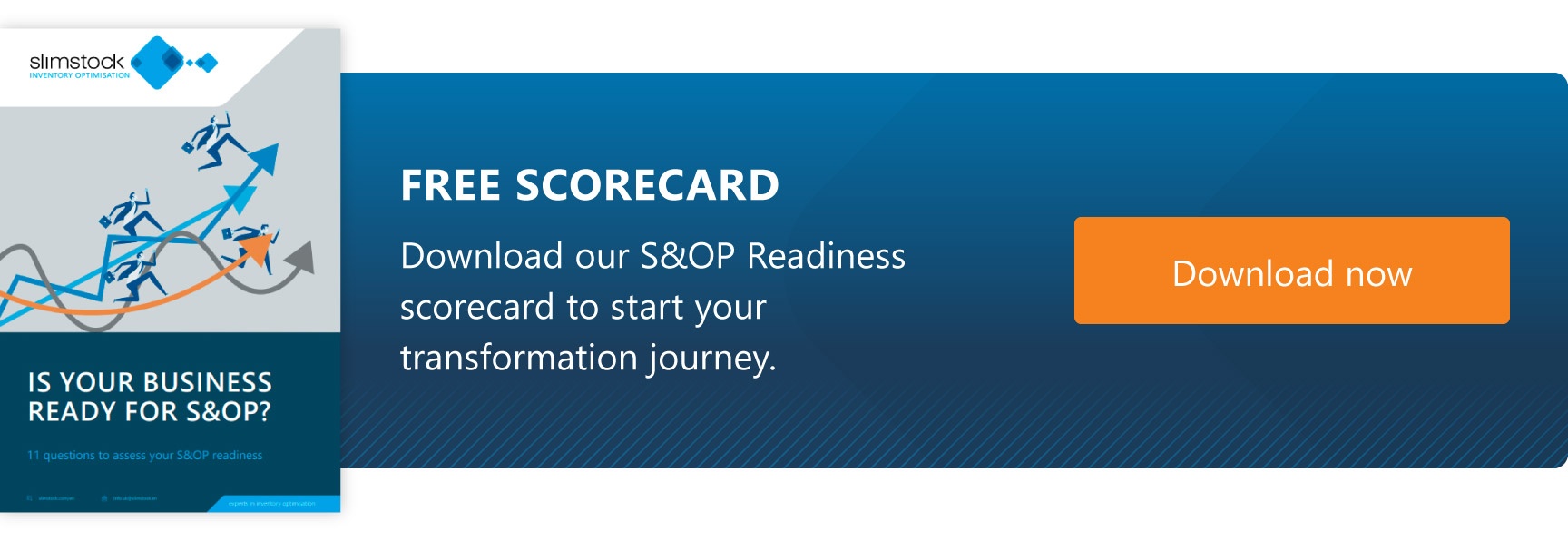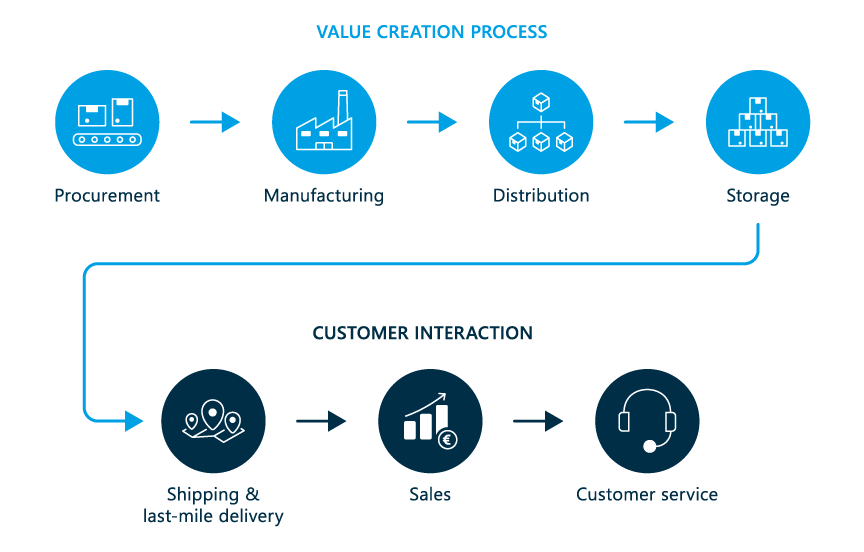Table of contents
Table of contents- The Journey to E2E Supply Chain Planning
- E2E supply chain planning as a solution to lack of visibility
- The dangers of siloed planning
- The links in the supply chain
- Connecting the E2E supply chain planning process
- Differences between traditional and end-to-end supply chain management
- Technology and automation vs. manual processes
- Steps for implementing end-to-end supply chain planning
- Assessment of existing resources
- A real customer example: How E2E planning can drive your growth
- Challenges of implementing end-to-end supply chain planning
- Conclusions and best practices in your E2E supply chain planning
- E2E supply chain planning FAQs
Disruption is the only certainty in supply chain planning. Yet, what if the latest source of upheaval isn’t driven by global conflicts, labour strikes, or the emergence of a new pandemic? What if your most recent challenge arises from an entirely unexpected quarter—the return to normalcy?
For many, the last few years have been a perfect storm. Battered by persistent upstream supply issues, erratic customer demand and tough economic conditions, planning teams have had a lot to deal with. Yet, it is that normalising of demand and supply that is now catching businesses out.
Take the market for outdoor sports equipment. As customers discovered a newfound love for outdoor exercise in the wake of the COVID-19 pandemic, demand for this type of equipment grew enormously. Unsurprisingly, companies increased their investment in inventory to satisfy the soaring demand.
Of course, even as the pandemic eased, there was little relief from supply chain disruption. This translated into significantly extended lead times, prompting numerous companies to place exceptionally large orders. This move served a dual purpose: it kept pace with the strong demand and helped to counteract the adverse impacts of these extended lead times.
However, as the months passed, both customer demand and lead times began to normalise. This caused many of these companies to face a severe bullwhip effect. Suddenly these businesses found themselves sitting on a mountain of excess stock. Forced to take action, many slashed prices to encourage customers to part with their cash.
Granted, many of these elements were unpredictable, and the organisations’ abilities to mitigate them limited. But, in the case of two companies in the same industry, which would have been better prepared to deal with this situation? The one that had visibility over its entire supply chain or the one that had only limited information on the other links in the supply chain?
Make no mistake. Many of these factors were totally unpredictable. And more importantly, the ability of these organisations to influence them was limited. But that is not to say that nothing could be done.
Picture this scenario: We’re assessing two companies within the same industry, both catering to the same customer base and sourcing from the same suppliers. Which company would you bet on as the frontrunner? The one relying on siloed planning, with minimal interaction with the wider supply chain? Or the one boasting crystal-clear visibility across the entire supply chain network?
This is no trick question. A business with true End-to-End (E2E) supply chain planning capabilities will always be better positioned to pivot to market changes.
E2E supply chain planning as a solution to lack of visibility
The reason why is simple. By creating visibility at every point of the chain, these businesses can detect variations in demand and supply sooner. They are better able to respond to challenges on the horizon. And by sharing information with supply chain partners, they can work with suppliers and customers to overcome volatility (or even normality).
End-to-end planning aims to unify departments across the internal organisation to obtain a single source of accurate information. But the value of E2E planning is in aligning every department’s strategies, tactics and actions with the wider business vision. As a result, E2E planning translates into greater efficiency and resilience of the supply chain.
The dangers of siloed planning
The worst of the disruption might be over (for now!) However, the risk of siloed planning and lack of communication between the different levels of the supply chain is still very much present. After all, business is becoming increasingly complex and the number of sales channels continues to grow.
In this article, we will explore the nuances of E2E supply chain management, its potential benefits and how it differs from the traditional approach to supply chain planning.
The links in the supply chain
But before we go into detail, let’s lay the groundwork by establishing the different links and processes that are part of supply chain planning.
Imagine you have entered an online shop and bought that product you wanted so much: a brand-new bicycle. It was easy, you went to the website, decided which one you liked the most and the next day, you received a knock on the door and your bike was there.
For you, it was very simple, but the truth is that someone had to develop a nice product design, source all the parts needed to manufacture the product, assemble the different components, and put the bike in a box. In short, from the conception of the product to the after-sales service, we can distinguish different links in the supply chain:

Procurement
In this phase, companies purchase the raw materials, components and services that are needed to produce the product they will market. Negotiations with suppliers, evaluation of the offers made by suppliers and the establishment of commercial supply relationships are some of the actions carried out in this phase.
Production
Raw materials and other semi-finished products purchased in the previous stage are transformed into finished goods ready for sale. Workflows are planned, resources are allocated and production is monitored to meet quality standards and market demand.
Distribution
After manufacture, the item must be transported to distribution centres or directly to the point of sale. Manufactured products are kept in storage facilities before being shipped to the final point of sale or delivered to customers.
Last-mile shipping and delivery
This stage involves the transport of products from warehouses to points of sale or directly to consumers.
Sales
In this phase, products are promoted and marketed to attract customers and close sales. It involves marketing strategies, advertising, promotions and negotiations with buyers.
Customer service
After the purchase, customer service comes into play. Responding to queries, providing technical support and dealing with complaints or after-sales problems are some of the most common tasks carried out by the customer service team.
We must also take into account product returns. In this regard, reverse logistics will pose a challenge, especially for companies operating in omnichannel environments and having to manage various sales channels, and, consequently, returns as well.
Connecting the E2E supply chain planning process
Just as the supply chain is made up of different links, supply chain planning is made up of different stages and processes which, when executed smoothly and without interruption, translate into operational efficiency.
But when each part of the supply chain is run in isolation and departments work in silos, the result is little visibility between them and huge inefficiencies across the board.
Do any of these “regrets” sound familiar:
- “We designed a state-of-the-art product, but we didn’t have the right parts to manufacture it.”
- “The product we developed was top-notch, but our customers didn’t appreciate it.”
Well, they are all the result of a supply chain that lacks visibility. This is what E2E is all about: implementing effective business processes through end-to-end supply chain collaboration. This is achieved through a holistic view of the supply chain and the digitisation of processes that enable easy scaling of company operations while reducing waste.
Let’s explore how the principles of E2E supply chain planning apply to your core processes:
Assortment planning
It begins with offering the right assortment of products. But what are the items you should offer customers? Well, those that help you get closer to your business goals. This means that the products that bring in the most margin are very important, as are those with a high sales volume that help you attract many customers, or items that your competitors don’t have and that allow you to differentiate.
Demand planning
It is impossible to plan anything in the supply chain without a clear picture of forecasted demand. Anticipating the future, using historical sales data, analysing market trends, and weighing up events that may influence demand will allow you to better anticipate the products you need. No more and no less. In this way, you will avoid falling into stock-outs or overstocks, both of which are extremely detrimental to your business.
Supply planning
Once you know what the expected demand is, you must have a plan to meet it and adjust to it without falling into excesses or stock-outs. To achieve this you need to optimise order quantities and ensure that stock is available at the right place at the right time.
Inventory Optimisation
If demand were a fixed and immovable number, this process would probably not make sense. Nevertheless, it must be borne in mind that demand for many items is volatile, as is the prices of raw materials and their availability. Therefore, inventory optimisation will consist of taking into account all these variables to be able to maintain the highest possible product availability at the lowest possible cost.
S&OP (Sales and Operations Planning)
Sales & Operations Planning is a key element in E2E supply chain planning. If E2E planning translates into visibility throughout the supply chain, the S&OP is the process that will allow all the information generated in the links to be accessible and understandable for all the people involved in the management of the supply chain. Likewise, it will also be the procedure through which the relevant decisions will be taken to adjust and optimise the rest of the processes.
Differences between traditional and end-to-end supply chain management
Traditional and end-to-end supply chain management share a common goal: to reduce costs and meet customer demand. However, the main difference between the two lies in the limitations of traditional management compared to E2E management. Let’s look at some of the main differences between the two:
Global vs. segmented vision
E2E: Approaches the supply chain as a continuous and connected process from suppliers to final customers, considering all intermediate stages and the different parties involved.
Traditional: Treats each stage of the supply chain as a separate entity, which can lead to a lack of coordination and limited vision.
Collaboration between links vs. isolation
E2E: Promotes collaboration and information sharing between all links in the supply chain for more informed decision-making and shared risk management.
Traditional: There may be a lack of communication and collaboration between different parts of the chain, which can lead to inefficiencies and coordination problems.

General objectives vs. individual objectives
E2E: The overall objectives of the company are the number one priority and the synchronisation of all links in the chain are required to achieve them. The particular objectives of each link and department are subordinated to those of the organisation.
Traditional: Often focuses more on the internal efficiency of each stage than on achieving the company’s overall objectives.
Technology and automation vs. manual processes
E2E: Technology is essential to provide the necessary visibility along the entire chain. Similarly, through technology, the most repetitive tasks linked to the supply chain can be automated, and teams can focus on higher value-added work.
Traditional: Is more likely to rely on manual processes and does not have the appropriate technological tools.
How can technology support effective E2E supply chain planning?
Effective E2E supply chain planning requires the right technology. Some of the features of this type of software are:
Planning is carried out at every level of the supply chain, thereby improving short-term responsiveness. Your supply chain decisions will obviously have an impact on your operations. In addition, they can also have spill over effects on other departments in your business. For this reason, anticipating and mitigating the risk of these decisions is critical. To achieve this, using digital twins to recreate the impact of these decisions is a great advantage.
Eliminate disconnected technologies
The right E2E technology will provide your team with a fully integrated platform for more effective supply chain planning. You can say goodbye to disjointed supply chain technologies that only cover part of your operations.
More complete visualisation of KPIs
You’ll have real-time visibility into KPIs and performance metrics segmented by product range, local and global locations, and other filters. By contextualising metrics through your team’s knowledge, you’ll get the information you need to make a difference.
Steps for implementing end-to-end supply chain planning
We have already reviewed the benefits and the main differences between a traditional and an end-to-end planning approach. The advantages of the latter, especially in complex supply chains, are numerous, but how do you move from the traditional model to E2E?
Assessment of existing resources
Before embarking on the transformation to an E2E supply chain management model, it is essential to thoroughly assess your existing resources. This ‘status report’ will provide you with information on technology gaps, process bottlenecks and resource constraints that need to be addressed during implementation. Keep in mind, too, that such a process will require investment, commitment from your supply chain team and trust from your board of directors.
Defining clear objectives
Clearly defined goals for an E2E supply chain planning initiative are critical to success. Do you want to improve delivery times, reduce operating costs and increase customer satisfaction, all at the same time? Whatever goals you set, they should be clear and measurable.
Selecting the right technology
Choosing the right technology is key. This step involves thorough research and consideration of software solutions that align with your organisation’s size, complexity and unique requirements.
Data collection and cleaning
Accurate and clean data drives effective supply chain planning. Before implementation, you need to make an effort to collect and clean historical data. Clean and consistent data is the basis for forecasts and plans that help you make good decisions in your supply chain.
Design of the E2E workflow
Designing a seamless end-to-end workflow involves mapping each stage of the supply chain journey. This step enables you to highlight interdependencies between links, potential bottlenecks, alternative paths and opportunities for process optimisation.
Implementation and user training
Once the technology has been selected and all the previous steps have been carried out in collaboration with the software provider of choice, implementation should follow. At the same time, users must be trained and provided with the necessary skills to ensure smooth adoption and use of the new tool.
Adjustments and continuous optimisation
Supply chains are dynamic and adjustments will need to be made over time. Regularly reviewing KPIs and gathering feedback from the team that is in contact with the technology will allow for continuous optimisation of your supply chain.
A real customer example: How E2E planning can drive your growth
Alipensa is a large consumer goods distribution group, which, in the last decade, has increased its turnover by 40% and has opened 15 supermarkets and 2 Cash and Carry centres.
At the same time, business development has also meant an increase in the complexity of Alipensa’s operations. To maintain this growth sustainably, the company decided to rely on Slimstock and implement Slim4 to manage its supply chain.
“We were at a point of expansion where we needed software like Slim4 to continue growing in an orderly fashion,” says Pedro Márquez Padillo, Logistics Director at Grupo Alipensa. After adopting the tool, the company raised its service level by 8 points to 98% in 9 months. This has enabled the company to maintain product availability as it continues to grow.
On the other hand, Slim4 also allows Alipensa to detect supplier promotions to take advantage of purchasing opportunities and carry out the replenishment process under the most favourable conditions possible. This is just one example of the benefits of having visibility over all the links in the supply chain (E2E planning).
Challenges of implementing end-to-end supply chain planning
When faced with the implementation of such an E2E process, one or more of the following challenges may be encountered:
Internal collaboration is essential: For the project to succeed, team collaboration and clear and transparent communications in all directions are essential.
Reaching agreements with suppliers: Collaboration with the upstream link in the chain is necessary for effective E2E planning. In this situation, understanding past behaviours can allow you to anticipate future ones, and therefore know which suppliers will be easier to “add to the cause”.
Know your customer well: To correctly satisfy your customer’s demand you need to know what they want, how they want it and when they want it.
Convinced leadership: To move the E2E project forward, it must be led by people who are at the top of the company and who really believe in it.
Conclusions and best practices in your E2E supply chain planning
Throughout this article, we have looked in detail at what end-to-end supply chain planning is about. We have reviewed its potential benefits, the steps you should take to implement it in your business and some potential ‘pitfalls’ you may encounter during its implementation.
In summary, it is right to point out that the process of moving from traditional to end-to-end planning is not quick and requires commitment from the whole organisation. But the potential benefits are so great that you cannot afford to miss the opportunity. The price of not undertaking the change would be too high for your organisation.
In our experience, some good practices you should keep in mind during the implementation process are:
- Make sure that people in the organisation are prepared. If they are not, help them and provide them with appropriate training.
- Define your objectives as per the link in the supply chain. Determine metrics to measure the success of the implementation (KPIs).
- Use the right technology tools, invest in systems and keep your data clean for reliable information.
- Implement an effective S&OP process.
- Generate and seeks strategic alliances with suppliers and customers.
In this way, you will facilitate the implementation of E2E supply chain planning in an agile and efficient manner.

E2E supply chain planning FAQs
What is end-to-end supply chain planning?
End-to-end supply chain planning consists of coordinating all stages of the supply chain, from raw material procurement, production, distribution and logistics to sales and customer care. This approach aims to improve efficiency and reduce costs by eliminating redundancies and improving visibility across the supply chain. By integrating systems, data and processes, lead times are minimised, problems are anticipated and a supply chain that is more agile and flexible to market demands is achieved.
What are the risks of siloed supply chain planning?
Siloed supply chain planning carries substantial risks by creating inefficiencies, lack of coordination, difficulties in anticipating demand, quality issues, compliance risks, lengthy response times, limited innovation and less informed decisions. Lack of visibility and coordination at individual stages results in higher operating costs, production and delivery delays, difficulty adjusting to market changes, and a reduced ability to make strategic decisions based on comprehensive data.
What is supply chain planning?
Supply chain planning is the process of designing and coordinating the activities and resources involved in managing a supply chain efficiently and effectively. It involves creating detailed strategies and plans to ensure that products and services get from suppliers to customers in a timely and efficient manner, minimising costs and maximising customer satisfaction. Some of the processes included in supply chain planning are Assortment Planning, Demand Planning, Supply Planning, Inventory optimisation and S&OP (Sales and Operations Planning).
What is the role of technology in end-to-end supply chain planning?
Technology is essential in end-to-end supply chain planning, improving visibility, efficiency and decision-making. Demand forecasting systems and data analytics enable better-informed choices. Similarly, technology also enables real-time monitoring of supply chain performance, as well as automating processes and establishing a management-by-exception model where planners can focus on true value-added tasks.






